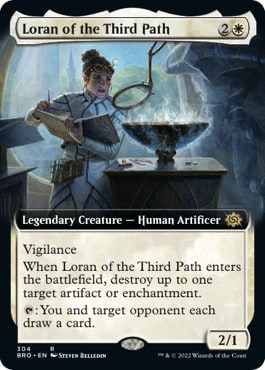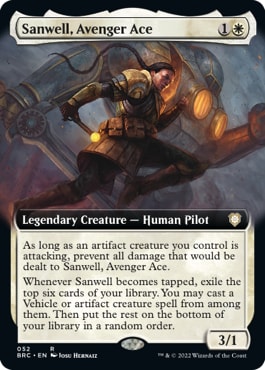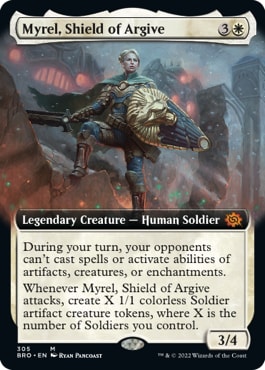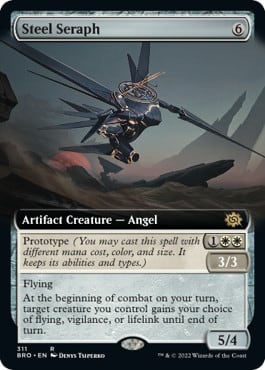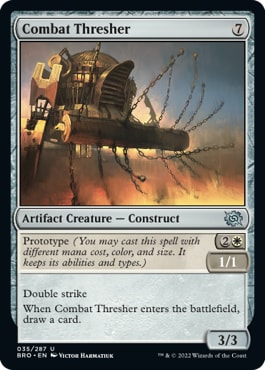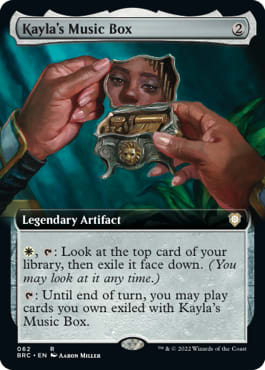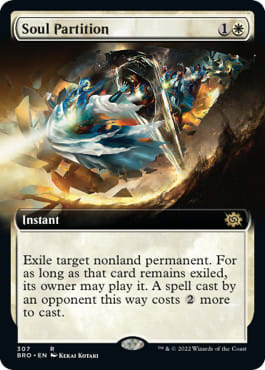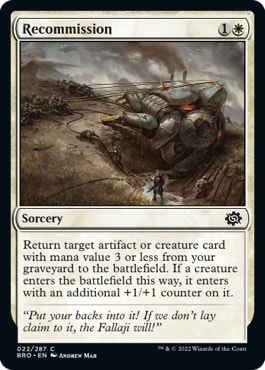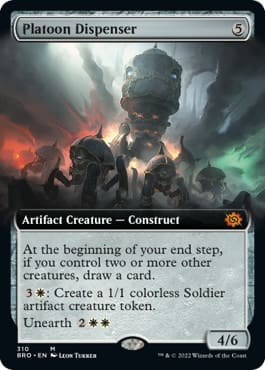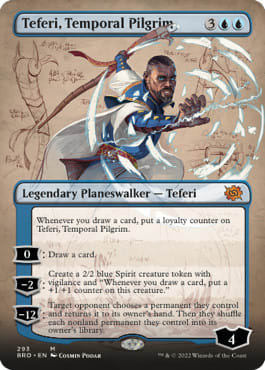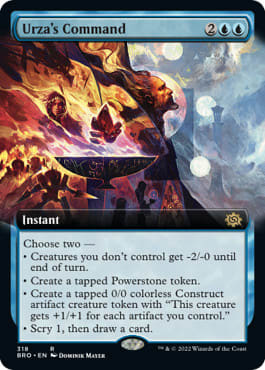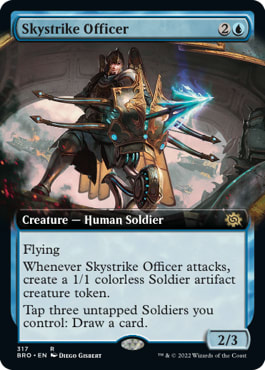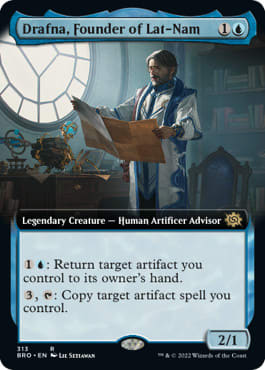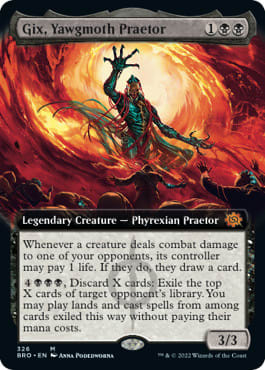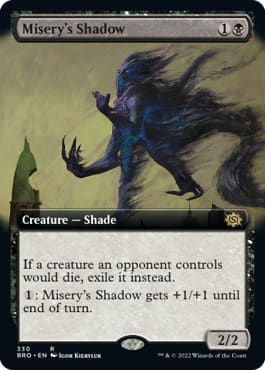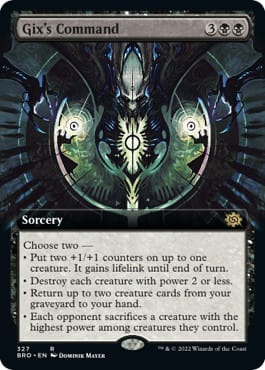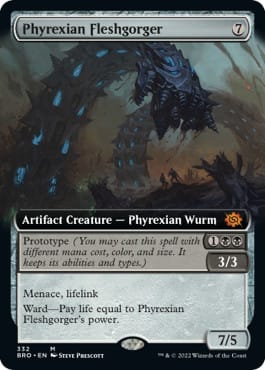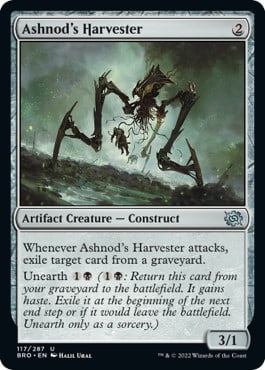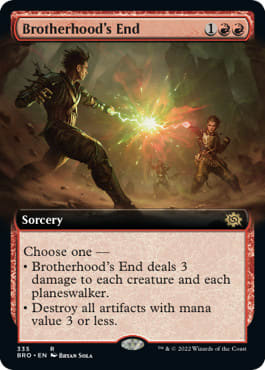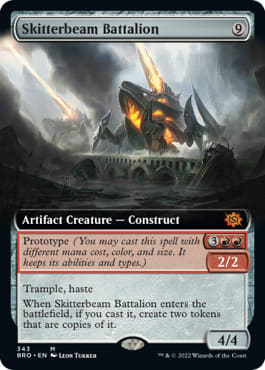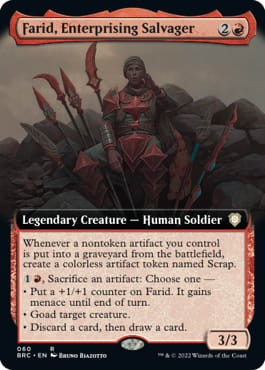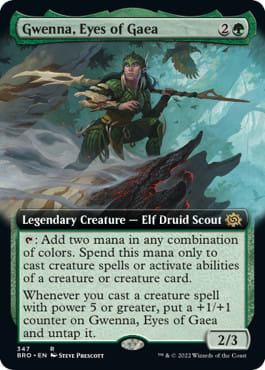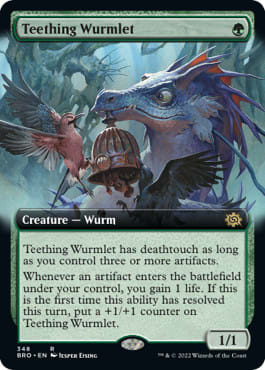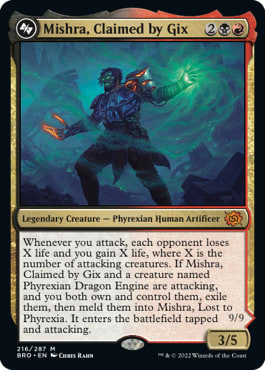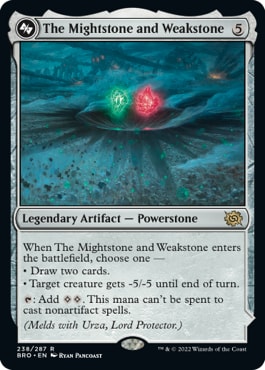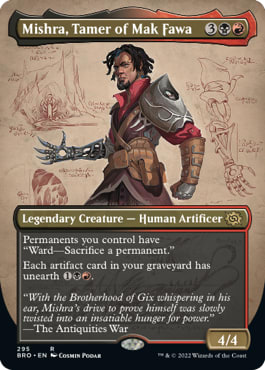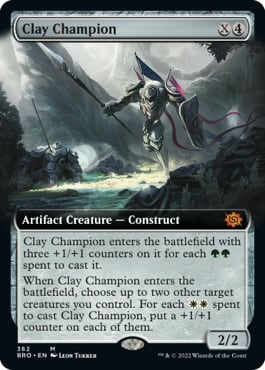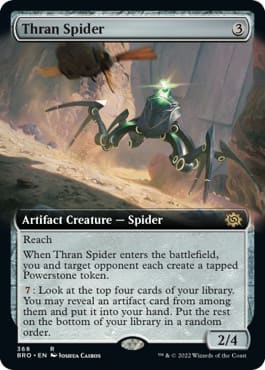In this article, I'll be reviewing cards from The Brothers' War and The Brothers' War Commander for Cube, breaking them down by color into section. I'll be including cards that are going to be at home in most "goodstuff" Cubes as well as ones that are worth considering if your Cube has more artifact-explicit support as mentioned in my Kamigawa: Neon Dynasty Cube review.
As usual, I've sorted the cards by approximate interest, but it isn't a definitive ranking and you should season to your Cube's tastes. I'll mention the set's keywords (Meld, Prototype, Powerstones) when talking about the cards themselves, but there isn't really enough to make a cohesive theme with them in a Cube world.
Skip to:
White
Recruitment Officer - It's been a while since the set's requisite 2-power creature for one mana was the card you'd expect to see the highest adoption rate (or close) in Cubes. Some of that may just be from us finally hitting a good number of early beaters to hit critical mass for aggro decks. It may also be that these new ones just aren't as good as the old ones (not counting cards like Mother and Giver of Runes), but I figured I'd mention this at the top of the article because of the ubiquity of these early beaters in Cube aggro decks.
This one has some of the better bonuses to supplement its 2/1 for ![]() stats, but it may not be quite as good as it looks (it's still good). It's true that it gives you something to do when flooding out, since it generally will hit a card with its ability in most aggro decks, but it's partially the illusion of quality since it's giving you something to do when you're helplessly flooding out. This is more of a hedge against a failcase rather than performing the primary function of an aggro creature - beating down efficiently.
stats, but it may not be quite as good as it looks (it's still good). It's true that it gives you something to do when flooding out, since it generally will hit a card with its ability in most aggro decks, but it's partially the illusion of quality since it's giving you something to do when you're helplessly flooding out. This is more of a hedge against a failcase rather than performing the primary function of an aggro creature - beating down efficiently.
With that said, it's a nice upside that actually does something rather than the mostly flavor text on cards like Venerable Knight, Dragon Hunter, and Hotshot Mechanic, most of which don't really help to efficiently beat down either. This places it relatively highly in the White 1-drop tier.
Lay Down Arms works well in both mono/mostly White decks and decks with a bunch of Plains-typed lands, making this an efficient removal spell. It's somewhat like Skred/Defile but this works better in the early game since it cares about the mana value of its targets, not toughness. Lifegain is an acceptable drawback for cheap removal, since aside from Swords to Plowshares, Path to Exile, and Swift Reconfiguration (and Sunlance), there aren't many good cheap options out there. Welcome to the club.
Loran of the Third Path - During preview season, these kinds of Naturalize-on-a-stick creatures have historically been seen as "Cube cards," with some being shown as official previews.
Having had a Cube since 2009, this does make sense in retrospect, as a lot of early Cube gameplay was focused on powerful artifacts - either with strategies like Wildfire/Upheaval/Smokestack, metagames that preferred signets in Cubes with lacking aggro support (I was fighting the fight to support aggro in Cubes back then, and was in the minority on doing so, although the improved quality of creatures these days have led many Cube designers to get on board eventually), mediocre 3-drop creatures which rewarded players for playing protection swords like Sword of Fire and Ice, and other power-level spikes like Wurmcoil Engine. Cubes that had fast mana further rewarded players for having a maindeck answer in their 40, and cards like Hearth Kami weren't uncommon in Cube lists because of this maindeck utility.
Historically, Green has had the lion's share of this effect as Naturalize has supplanted Disenchant as the "base" color for this type of effect, although we've seen a few in White - Leonin Relic-Warder and Cathar Commando - this is the cheapest that we've seen for a Reclamation Sage effect in White that doesn't require sacrificing the creature or giving it back to the opponent when the creature dies.
The Limited Level-Ups episode about The Brothers' War talked about how maindecking Disenchant effects works well in BRO, much like how Destroy Evil did in DMU, as it generally has at least one target to hit. The second and third copies have diminishing returns because, much like with Portable Hole, a deck will generally have a target to hit in a game but there may not be multiples. That said, it's nice to have one of these in pocket and this is a good one to have in your White Cube decks' starting 40.
Also, even though the symmetrical draw ability looks to be flavor text, aggro decks utilizing Loran tend to have fewer lands and thus, tend to have fewer dead draws with it and can more quickly utilize those draws, especially if it's doing so for lethal. When digging for something when you're dead anyway, using her draw isn't a bad proposition because, well, you were dead anyway, so it'll happen more often than you'll think. All in all, a welcome addition.
Sanwell, Avenger Ace - In the Kamigawa: Neon Dynasty Cube review, I talked about how some cards like Michiko's Reign of Truth // Portrait of Michiko can provide some nice payoffs to push your White aggro sections to be more artifact-centric. Backed up by a 1-drop artifact creature (Bomat Courier, Esper Sentinel, Gingerbrute/Stonecoil Serpent), this is very difficult to kill in combat and usually draws a card if your deck wants to play Sanwell. Definitely not for every Cube, but something to consider if you're looking to enable cards like Cranial Plating and Nettlecyst in your Cube aggro decks.
Scholar of New Horizons is White fixing that can possibly ramp if you're behind, and this is one of the few types of this effect that doesn't require being behind when cast, like Knight of the White Orchid, Space Marine Scout, and Tithe. Its bear stats are pretty small for the cost, which may be what results in it not making it into Cube decks.
Myrel, Shield of Argive emulates cards like Hero of Bladehold as a snowbally attacker, trading consistency with token generation and battle cry with a Grand Abolisher ability. This helps to negate the drawback of Myrel dying to a Doom Blade. I've cooled my opinion of Hero of Bladehold in recent years and I think White 4-drops have eclipsed Myrel, especially with cards like The Wandering Emperor and the White Squad 4-drops (Ultramarines Honour Guard, Zephyrim and, to an extent, Space Marine Devastator) from 40K, but this is a nice replacement if you're still playing Hero.
Siege Veteran plays like a bigger Luminarch Aspirant as it's essentially +1 mana for a +1/+1 version of it, which isn't bad as a standalone threat. Given that White 1- and 2-drops are spread across a variety of types (remember the Warrior subtheme in Fate Reforged?) allows a Cube designer to make a soldier subtheme a venue for White aggro decks without having to compromise power, which is always a great feeling for a Cube designer, as the Veteran's soldier death trigger gives some value to early creatures dying.
Steel Seraph - Although Phyrexian Fleshgorger has gotten most of the attention for being a Vampire Nighthawk-style creature, I'm slightly more bearish on this than Fleshgorger. It only giving something lifelink on your turn is a bit of a bummer, but usually lifelinkers are attacking for lifeswings anyway, so it's not as big a deal as you may think. Essentially, this trades Fleshgorger's menace for flying, and ward for the ability to put lifelink (or flying/vigilance) onto another creature - a nice upside when something bigger comes along. It's nice for racing scenarios and for immediate impact by giving a 2-drop evasion, a welcome ability in an aggro deck. This all may just be apples to apples, since White 3-drops are more competitive than Black 3-drops and this set itself gave White Loran, Siege Veteran and Combat Thresher as competitive White 3-drops. However, I still do like how well this plays to scale up when other threats scale up in the later stages of the game.
Speaking of scaling up, this is a good time to talk about Prototype.
For the most part, Prototype creatures play as being cast for their prototype mode, with their full cost being used if you have nothing better to do. In Cube, you can cheat getting the full mode into play by prototyping something and then later blinking it, or reanimating it from the graveyard, which can be a nice way to increase the number of "hits" for cards like Flickerwisp.
These facets can help to tip the scales toward inclusion in a Cube, if you want to bolster those decks by giving them a payoff for playing an already-fine-on-rate card like this.
Combat Thresher is better than you may think as a Roving Harper with "kicker" to go big. That said, this is still pretty medium because of its relatively small combat stats. It might secretly be a Selesnya card, though, as this does something for value on turn three or cast on turn two via a mana dork, either case playing well into Selesnya decks' usual gameplan. Going full mana cost lets this be a giant beatstick, which can be easier to hit than for most prototypes, due to mana dorks, etc.
Yotian Frontliner is a 2/2 for one that requires some work to get there, since it needs a buddy to get value and is just mediocre if it's attacking solo. Unearth is nice as removal insurance when you need to kill an opponent at low life, since White aggro decks can have an equipment at the ready to suit this up to make this swing for more than just 1.
Kayla's Music Box is one of the cheaper White Tome effects that we've seen - similar to things like Mazemind Tome and Reckoner Bankbuster, although it's worse in the face of removal. I note this here because it's one of the cheapest of this effect that we've seen and since it only requires a single White mana to "draw" it's easy to use fallow mana if you're slightly off curve and/or holding up counter magic, and it doesn't blow itself up when you need to cash it in. I'm still skeptical, but it may be better than people think.
Urza's Sylex is this set's mass removal a la Karn's Sylex, Perilous Vault, and Nevinyrral's Disk. A unique function of this is that it does destroy some lands if there are a boatload of them out, but this is mostly just a Disk effect that can tutor for a planeswalker if "kicked" on exile. Most of White's walkers gum up the board really well, so I do like how this represents some action to break parity once the world has been destroyed. Sorcery speed activation does hurt, but it's expected. I'd rather personally have a Wrath in my control decks but this can be some nice spice.
Soul Partition plays like a bounce spell that taxes playing the card again at instant speed. I've seen comparisons to Fateful Absence, where instead of a clue, the opponent essentially gets the card back after cracking the clue. Generally, I think this is mainly a tempo card for getting annoying things off the board temporarily, since the opponent getting the card back doesn't matter if they're dead, and this plays more into White's wheelhouse than Blue's - at least in most Cube metas.
Kayla's Command isn't too bad as a White pseudo Civic Wayfinder for basic plains, but White 3-drops (Combat Thresher and Loran included) are better than this and even with the other modes, modes like its lifegain plus scry or counter ability aren't enough to supplant better creatures.
Autonomous Assembler is a filler White robot that's essentially Chronomaton with a slight glow-up by having vigilance, so it growing doesn't require it being on defense/can act as an on-board combat trick. Being cast for five means that it should only take a few turns for it to outclass most other threats, but it's still mostly a B-side. Still, due to its middling base stats, even with its bells and whistles, it's still just a filler aggro threat.
Repair and Recharge is a Breath of Life that can get back Planeswalkers and gives you a Powerstone for your trouble. Reanimating planeswalkers is a unique effect, but at the end of the day, it's still five mana to reanimate something with not much else to show for it aside from a Powerstone.
This is a good time as any to talk about Powerstones.
Since they cannot cast non-artifacts, but can be used for other things, in a Cube world, they're mainly used for these purposes:
- Casting artifacts (duh)
- Powering mana sinks (equipment, etc.)
- As a game piece for use as a resource
Use #1 is pretty straightforward - Powerstones help to cast and activate artifacts and the value of that in a deck is proportional to the number of artifacts that can use Powerstones. Uses #2 and #3 are harder to grok, since this is a resource that we aren't used to accounting for, and it's easy to underrate those types of unknowns.
Use #2 tends to be seen in Cubes as powering equipment costs, since planeswalkers don't require the use of mana, although there are some nice other uses for case #2, like powering up a Vedalken Shackles, the back side of Fable of the Mirror-Breaker // Reflection of Kiki-Jiki and other such cases - but they're in a low enough dose where there aren't enough to build around, just a nice little bonus. For the most part, in a lot of Cube decks, there aren't many uses for this, but this may change with newly printed cards that can use Powerstones.
Use #3 is, ironically, not that well represented in White (but works with some standbys like Tangle Wire and Smokestack) but tends to be more represented in Black and Red through sacrifice shenanigans like both versions of Braids and newcomers like Gut, True Soul Zealot. You may find it to be a better payoff when paired with Black and/or Red decks.
Applying this to Repair and Recharge - decks that are in the market for a Zombify aren't really in the market for a mana sink, since they're usually trying to cheat something big into play and don't have a lot of uses for case #2 (at least for things like equipment) and are a nombo with case #3. Its best use is if you're looking for White decks to pair with casting large artifacts, if that's something you're looking to do.
Recommission - I'm mentioning this briefly as a white Unearth (the card, not the mechanic) but one that can't cycle, which was a useful effect to have when it was a dead draw. Getting back artifacts is a nice bonus, but it still just feels like it doesn't do enough outside of rarity-restricted Cubes.
In the Trenches - Historically, anthems have been strong in Limited, but generally those formats tend to be more about card advantage and jockeying for position, rather than true aggro beatdown gameplans. Because of this, I've fallen further and further in love with anthems in aggro decks, since they require a few creatures on board before you've gotten your mana's worth. The ![]()
![]() upside helps and is more in line with midrange decks that spit out tokens, since those decks can more reliably hit six mana. I'd rather play just about any Planeswalker in a White deck, but if limiting walkers, this isn't a bad option to consider.
upside helps and is more in line with midrange decks that spit out tokens, since those decks can more reliably hit six mana. I'd rather play just about any Planeswalker in a White deck, but if limiting walkers, this isn't a bad option to consider.
Platoon Dispenser is a more expensive version of Oketra the True as a virtual Dude Ranch that snowballs, by drawing cards when you have an army out. At least it can attack and block without help. The issue with these kinds of token generators (Oketra, Mobilization, Sacred Mesa) is that they tend to take a lot of mana to get going and planeswalkers, especially White ones, have supplanted the role of token generators in Cubes. Cards like Sacred Mesa and cards that generated value over time like Waterfront Bouncer and Crystal Shard took over games when Cubes were less focused, but with better threats and removal, this doesn't apply as much these days.
Even with its unearth, which can draw a card out of it, I just don't think this does enough for a Cube 5-drop these days.
Blue
Arcane Proxy isn't quite Snapcaster Mage, but it's still great with cantrips, which can naturally accumulate in the graveyard when playing the Blue game. It's a nonbo with counterspells (for the most part) and you don't get a ton more value out of full cost, but it's still fine and the deck has some 4-mana targets lying around. It's true that a lot of these kinds of Snapcaster-at-home riffs, like Sea Gate Stormcaller and Dualcaster Mage, haven't been anywhere near as good as Snapcaster, but I'm a fan of Arcane Proxy because of how well it integrates into playing Blue decks without having to go out of your way to get benefit. Combining this with other colors' removal is excellent too, as being able to double up on your Doom Blades is an absurdly good chunk of value for three mana, so it'll be in a pretty good spot most of the time.
Teferi, Temporal Pilgrim is one of the better Blue tap-out threats in recent years. He ticks a lot boxes for a good planeswalker: draws cards, defends itself, and has an ultimate that does something if need be.
Teferi does require some setup since, when creating his first Spirit, it's pretty small as a 2/2 and may just be relegated to chump block duty when it doesn't have counters on it. However, that dynamic quickly changes once you untap with him since he can snowball the board with Spirits and the Spirits themselves start to snowball to become actual threats. Vigilance is great on these as well, since they can help to hold the fort - usually first just staying back since they may be too small to swing into an opposing board, and then attacking when they're bigger than anything else.
Teferi also gets better with more cheap cantrips and can act as top-end to a deck that's loading up on cantrips. He also combines incredibly well with other Planeswalkers that draw cards, letting him act as a Gideon Jura-style "Planeswalker defender", which is a familiar play pattern to anyone who saw Gideon Jura alongside a Jace in years' past.
Much like with Arcane Proxy, when looking at other colors - since most Blue Cube decks aren't Mono-Blue, Teferi does have some competition in decks with cards like Teferi, Hero of Dominaria (few things are as absurd as he), Ashiok, Nightmare Muse and others, but this still punches well into that weight class.
Surge Engine - One thing that I like about this is that it has a surprisingly good starting statline as a 3/2 defender for ![]() ; although most defensive Blue decks would prefer something like a 2/3 that can survive in combat against 2/1s and 2/2s, this is still a fine roadblock. Being a "leveler" lets this play well into Blue's gameplan of having something to while holding up interaction/cantrip mana and helps it to not be restricted to just Blue tempo decks (something I mentioned in the Kamigawa: Neon Dynasty review when talking about blue's ninjas) but in Blue control decks, it's not too bad to play this with counter magic up to protect it - if you've been playing Standard, you're likely familiar with this gameplan with Tolarian Serpent and Haughty Djinn. While I think cards like Tolarian Serpent and Sailors' Bane are better for those decks, this straddles the line for those decks and tempo decks well enough to make this see more Cube lists than one may think.
; although most defensive Blue decks would prefer something like a 2/3 that can survive in combat against 2/1s and 2/2s, this is still a fine roadblock. Being a "leveler" lets this play well into Blue's gameplan of having something to while holding up interaction/cantrip mana and helps it to not be restricted to just Blue tempo decks (something I mentioned in the Kamigawa: Neon Dynasty review when talking about blue's ninjas) but in Blue control decks, it's not too bad to play this with counter magic up to protect it - if you've been playing Standard, you're likely familiar with this gameplan with Tolarian Serpent and Haughty Djinn. While I think cards like Tolarian Serpent and Sailors' Bane are better for those decks, this straddles the line for those decks and tempo decks well enough to make this see more Cube lists than one may think.
Hurkyl, Master Wizard also plays incredibly well with cheap cantrips (a theme!) and double spelling on your turns to ensure that her end of turn trigger gets a card - but usually, if she's cantripping, she's going to hit another cantrip. A 2/4 for three isn't a bad body either, and even if you're not getting a free card every turn, she accumulates more than enough cards in the average game to have her be a nice main phase play.
Fallaji Archaeologist is what Augur of Bolas wanted to be for Cube. Augur tended to find itself whiffing too often in Cube and subsequently ended up leaving a lot of Cubes. Increasing the pool of hits from instants and sorceries to any non-land revealed is a nice upside and helps to make sure that it's emulating a cantrip more often than not, as Frank Karsten mathed out the exact odds on hitting with this. Overall, this works well in the same decks that would play Arcane Proxy. The failcase of being a two-mana 1/4 means that it stonewalls pretty much all 1-drops and most 2-drops (nice Porcelain Legionnaire) so it's not a bad consolation prize.
Zephyr Sentinel - Every once in a while, we'll see these kinds of Flash 2/1s for two in Blue. As mentioned in the Kamigawa: Neon Dynasty review, creatures like Spectral Adversary, Brineborn Cutthroat, Dimensional Infiltrator, and Merfolk Trickster which don't tend to do a lot in Cubes aside from those explicitly pushing tempo strategies. Having the bounce trigger as optional helps with making this a playable two-mana flash threat, if you need to ambush an attacker or a planeswalker.
In tempo decks that aren't ![]()
![]() , it likely isn't going to get a counter, but this two-mana flash creature is has the highest impact (thanks to it acting as a protection effect and/or way to re-use ETB triggers, if need be) aside from Snapcaster Mage and, depending on the deck, Brineborn Cutthroat. I tend to be cautiously optimistic about these kinds of cards because I'm biased to liking cheap flash threats, and I'm similarly cautiously optimistic here, but perhaps less so than I used to be.
, it likely isn't going to get a counter, but this two-mana flash creature is has the highest impact (thanks to it acting as a protection effect and/or way to re-use ETB triggers, if need be) aside from Snapcaster Mage and, depending on the deck, Brineborn Cutthroat. I tend to be cautiously optimistic about these kinds of cards because I'm biased to liking cheap flash threats, and I'm similarly cautiously optimistic here, but perhaps less so than I used to be.
Urza's Command's base mode depends on the artifact density of your Cube, as its best use is to at least generate a tapped Karnstruct, and it really starts to gets its mana's worth when the Karnstruct is a 3/3 or larger. The token entering tapped does prevent it from ambushing a creature in combat (I feel like this was a change made in development), but it's still good at attacking opponents or planeswalkers after untapping. The other modes are generally fine, with the scry plus draw being the generically best mode, the Powerstone being the worst and the shrink mode being contextually useful. That said, the star attraction is the token, so Cube inclusion is mainly dependent on how big the token can be.
Skystrike Officer is somewhat of a Blue Goblin Rabblemaster, an effect we've seen a few times in Blue with creatures like Mist-Syndicate Naga. Having evasion helps, but having no immediate impact, which the best Rabblemasters (Goblin Rabblemaster, Squee, Dubious Monarch, Legion Warboss) have, is a loss, since the tokens also don't enter the battlefield attacking. So, unlike those creatures, its snowball effect is pretty slow and the tap ability is mostly flavor text in Cube, unless you're in ![]()
![]() . I've seen some hype for this card but I don't think it does enough as a non-flash threat, as cards like Hurkyl fit the main phase threat Blue gameplan better.
. I've seen some hype for this card but I don't think it does enough as a non-flash threat, as cards like Hurkyl fit the main phase threat Blue gameplan better.
Drafna, Founder of Lat-Nam works incredibly well with cheap artifacts since the extra ![]() tax can be used with them (although
tax can be used with them (although ![]() is certainly a very *real* cost) and cards like Chromatic Star/Sphere can extract that into real card advantage, a la Experimental Synthesizer. Its Goblin Piker stats aren't the best, but it at least lets him be deployed on the cheap and isn't a bad build-around for cheap artifacts if you're in the market for one.
is certainly a very *real* cost) and cards like Chromatic Star/Sphere can extract that into real card advantage, a la Experimental Synthesizer. Its Goblin Piker stats aren't the best, but it at least lets him be deployed on the cheap and isn't a bad build-around for cheap artifacts if you're in the market for one.
One with the Multiverse is another "cheat" card that plays somewhat like Future Sight by letting you cast things from the top of your library, but in all reality, your 8-drops should be winning the game on their own.
Forging the Anchor is only really playable with an extremely high artifact count and very poor elsewise.
Defabricate - More a Stifle than a counterspell, but generally, soft counters are better. Scatter Ray, which is better than it looks, as a four mana tax is just about a hard counter, and does the job better for disruption.
Geology Enthusiast is a mana sink that draws cards, and her Powerstones help to power up her draw ability, but it's still too much mana. Every once in a while, we'll see cards like this (Faerie Formation) which just don't do enough in Cube. This is another.
Terisian Mindbreaker is a robot that mills, but is a pretty weak wincon. Anyone remember Nemesis of Reason?
Black
Transmogrant's Crown - I'd be remiss if I failed to mention this set's Heirloom Blade, but this looks like it's actually a good equipment, something we don't tend to see much these days. It checks all of the checkmarks - a decently cheap cost, a very cheap equip cost, a good buff to power and outright drawing a card on death helps get value out of your cheap creatures and even on midrange beaters. The power buff also helps to make recursive creatures harder to ignore, which can mitigate their weakness of relying on combat to trade them off if you're low on sacrifice outlets.
Gix, Yawgmoth Praetor is essentially a bigger colorshifted Edric, Spymaster of Trest that pings you on draws. Like Edric, while it has no immediate effect when cast, generally it draws a card in an aggro deck via its saboteur trigger. Its discard ability isn't flavor text, but generally aggro decks aren't looking for a failsafe on turn seven since that's major flood time (and thus, may not have cards to sandbag for that either), but it's more live in aggressively slanted midrange decks. Overall, his early game use is nice to have as a way to boost Black aggro decks.
Misery's Shadow is just about impossible to block early in the game because of threat-of-activation which makes it one of those aggressive creatures that is solid on turn two and isn't irrelevant on turn seven either. Since the mana to pump is colorless, it means you aren't tied to specific mana, which is nice when sizing up against larger threats later in the game in 2-color aggro decks. Its exile ability is nice when it matters, but this is mostly a Shade with 2022's power level in mind, and thus this should do some nice work in aggressive decks.
Razorlash Transmogrant - Being a two-mana 3/1 with recursion that can't block, its closest analog is Scrapheap Scrounger. Since ![]()
![]()
![]() to recur this can monopolize a turn, it's worse than Scrounger, but it's still a very good card to supplement Black aggro strategies, especially with it coming back as a 4/2 at instant speed. Later in the game, even against opponents who aren't being greedy with their non-basic lands, this still can come back for
to recur this can monopolize a turn, it's worse than Scrounger, but it's still a very good card to supplement Black aggro strategies, especially with it coming back as a 4/2 at instant speed. Later in the game, even against opponents who aren't being greedy with their non-basic lands, this still can come back for ![]()
![]() . Even late in the game, a constantly recurring 4/2 is a real threat. One slight against this is that it's harder to splash the recursion ability, but you'd be surprised at how often a colorless Blade of the Sixth Pride is the right call to play in the final 40 of an aggro deck since you want to get enough warm bodies to punch the opponent to death.
. Even late in the game, a constantly recurring 4/2 is a real threat. One slight against this is that it's harder to splash the recursion ability, but you'd be surprised at how often a colorless Blade of the Sixth Pride is the right call to play in the final 40 of an aggro deck since you want to get enough warm bodies to punch the opponent to death.
Gix's Command's modes are mainly value-focused - either via its removal options with its wiping small creatures and making the opponent sacrifice a big thing, or getting creature value by recurring dead bodies/making one of your creatures larger. Its base mode is using both removal options when you're behind and using a removal option + bringing back 2 creatures, with the boost ability being the least used option that can be nice to have in pocket. Consider this mostly as a value card rather than a mass removal one, since it can't reliably wipe boards but generally it can at least get some 2-for-1s, like most commands tend to do.
Phyrexian Fleshgorger is better than Nighthawk Scavenger and Vampire Nighthawk; flying is just so so much better than Menace as evasion, but trading flying and deathtouch for menace and ward and "kicker" is a nice overall upgrade.,
One issue is that, depending on the matchup, the Ward life tax may not be that relevant (a Red aggro opp isn't going to care about paying 3 life to bolt it, and a Jund opponent may just shrug off a 3 life loss to kill something that will punch a planeswalker) but it's a small hedge to help some of the natural drawback that Baneslayers like this can have from dying from removal.
The prototype "Kicker" is nice by helping Ward scale up to where an opp can't just ignore the Ward life tax; ironically, other Nighthawks can help you get to the later stages of the game when you're able to cast Fleshforger for full cost, so there may be some argument to not just swap this for a Nighthawk, but it's not bad as a mid-tier Black threat.
Ashnod's Harvester is a Black filler aggro creature with some side benefit of hitting the graveyard. It also, in a pinch, can act as a support card for sacrifice/recursion, but it's only a one-shot effect. Still, it at least exiles something from the grave when it does unearth and attack. Filler otherwise.
Emergency Weld - I mainly am mentioning this for non-rare Cubes, as it's one of the cheapest Gravedigger effects we've seen and it has some Cube potential but I don't think it cracks in with rares in the mix. It's an effect that I hope gets power crept to rare, although one could say that Phyrexian Missionary is just that.
Ashnod, Flesh Mechanist is a Typhoid Rats that can scale up via its activated ability to turn dead bodies into tapped Zombies. It gives me Graveyard Marshal vibes, but costing five is just so high that it pretty much monopolizes your mana. Sacrificing creatures does help with the five-mana cost, though. I've heard some rumblings of this being potentially good but I'm not on board, yet.
Thran Vigil - Generally, cards that give counters are centered in White and Green. As @Cubedraft on twitter noted, this works incredibly well with cards like Murderous Redcap and other persist creatures, especially since this doesn't have the "once a turn" rider that these kinds of cards tend to have lately, making this a nice engine card for creature combos if that's a thing in your Cube.
Wreck Hunter is one of the few cheap flash creatures, but there isn't really a good payoff for powerstones as mentioned earlier. Getting a trio of powerstones from dead things can help with equipment costs, but even with this having some of my favorite stats as a 2/2 flash for two, this just doesn't do enough. Artifact sacrifice synergies may help increase its worth, though.
Terisiare's Devastation requires having a lot of artifacts up front to be a mass removal at a decently efficient rate, and the payoff of having a big wrath that also costs you life isn't that great. Powerstones are nice but not worth the big life loss.
Hostile Negotiations - As a virtual instant draw 3, mill 3 for four in Black, this is something we don't tend to see and this can help dump things into the graveyard. It's nice that it's a pretty unique effect in Black and milling helps graveyard strategies, but the inefficiency is still a bit high for the mana cost. It emulates Fact or Fiction for fun factor, but at the end of the day, it's still just a draw 3.
Terror Ballista is a bit too expensive at seven mana for what the card wants (something to sacrifice cheap fodder), but Menace at least helps it make sure that it doesn't die in combat. Still, sacrifice decks generally just want something cheaper and/or more highly and immediately impactful (since its ability is an attack trigger) than this. Unearth helps but it's still too pricey upfront.
Red
Brotherhood's End may be one of the best Red wraths of all time since it has such a great spread across matchups. If your Cube has mana rocks, both sides of Brotherhood's End allow it to be useful in aggro and non-aggro matchups since it's likely going to at least kill something and generally will at least 2-for-1 in the average game. Even if your Cube doesn't employ mana rocks, it may be able to sweep up small value creatures (although mana rocks certainly make this more maindeckable.)
Being an absurd sideboard card, though, certainly has its merits for finding its way into your Cube, as it isn't as direct as something like Pyroblast/Red Elemental Blast types of effects which are - for the most part - solely sideboard cards.
Mishra's Research Desk is similar to "yolo draw" effects like Reckless Impulse, Light up the Stage, Experimental Synthesizer and most Chandras, and it's nice that it doesn't require you to play the card this turn. That helps on turns when you unearth it. Like Synthesizer and Light up the Stage, this rewards players for playing a ton of cheap cards by being able to convert those resources into more cards. I've taken more of a liking to this kind of card and if you've liked Experimental Synthesizer, you'll like this too. Extra bonus points if you're playing Urza's Saga and are able to have both in the same deck!
Goblin Blast-Runner - While a lot of the cards that "require support" in this set are cards that require artifact support, this is one that works with 2 classes of cards:
- Fetchlands
- Sacrifice effects
With a critical mass of either effect (I'd say around 8-12 of category 1 and/or 2) this is one of the most efficient pound-for-pound beaters in the format as this can pretty reliably punch for 3 evasive damage, since menace is at its best in the early game when there are fewer bodies around to block. It does have some "threat of activation" a la Misery's Shadow if the sacrifice outlet is instant (most usually are) which helps as well. Like Scrapwork Mutt, it's another one that I'm cautiously optimistic about but it's a card that can slot relatively easily into sacrifice decks, if that's something in your Cube meta.
Feldon, Ronom Excavator - His ability to "yolo draw" is effectively a combat death trigger aside from times when the opponent chump blocks it. It's effectively game over if the opponent has a big board and can gang block it, to turn the upside into a drawback. For the most part, this draws a card upon trading in combat or against burn spells, which is fine. Haste helps this act as a consistent damage dealer, but it's hardly top-tier these days.
Scrapwork Mutt - Cards like Fissure Wizard and Immersturm Raider have always been on the cusp of playability in Cube but haven't broken though because of their relatively mediocre bodies. Unearth doesn't really help on that front, but does help with getting value once the creature gets outclassed. To do that, it has to die, and the opponent can just ignore its Goblin Piker body. Dumping bodies in the graveyard is nice, and I've seen cards like Merfolk Traders used effectively in reanimator decks as a Putrid Imp-style one-shot effect, and being castable for two colorless works for those decks (and Unearth can help in the late game if you need to dig.) I'm very cautiously optimistic on this card having enough of a spread across aggro and decks that want to dump things in the graveyard, but I wouldn't be surprised to see it get there in Cube lists as a filler 2-drop. Bitter Reunion also fills the role of "Red card that dumps things into the grave" but it's more linear than this - which isn't necessarily a bad thing, but it won't make it into aggressive decks either. At least, not good ones.
Mishra's Command's modes are lacking something that goes to the face, but arguably, that's what the haste/pump mode is for. Its other modes are nice for dealing with creatures/planeswalkers and being able to 2-for-1 with this helps with the mana inefficiency of this. If need be, pitching cards in your hand for other random ones is a nice fail case. The "base mode" likely is 2-for-1ing when at parity and killing a blocker and pumping an attacker if attacking for lethal or casting this out for three mana to emulate Prismari Command's shock plus loot mode. That will happen more often than you'd think, although you may find yourself getting got by it requiring 2 targets, so it can't just be used to rummage without something to burn/pump.
The relative mana inefficiency makes it a hard sell in pure aggro decks, making it more at home in aggressively-leaning midrange decks (that have a lot of creatures to pump for alpha striking) and generic red midrange 2-for-1 decks. Thinking of it in that context makes it look more appealing than as a middling Red aggro card.
Phyrexian Dragon Engine - Mostly a 4-power beater for three, which is decent by 2022 creature standards. Its unearth ability lets it play similarly to Earthshaker Khenra in Red decks as a beater that gets in early and gets some value out of drawing some cards to hopefully finish the opponent off. I like that its unearth acts as death insurance, which helps when it dies to removal, and it usually at least draws a few live cards when Unearthed. This has some potential in low-to-the-ground aggro decks that are looking for something to go slightly big as a finisher.
Skitterbeam Battalion - My concern is that the bodies are too small for the cost when prototyped, although it is at least more haste damage than the many five-mana dragons that we've had over the years, even Thundermaw Hellkite (although Skitterbeam's tokens' evasion is much worse). This seems like it's mostly for decks that care about creating multiple bodies and less so for ones looking for pure damage efficiency.
Obliterating Bolt - If Thundering Rebuke and Lava Coil had a baby, it'd be this. This essentially is a small Hero's Downfall like Thundering Rebuke, but it exiles things for times when that matters. Mostly just a small upgrade for Cubes running either, but unlikely to supplant more premium burn.
Mechanized Warfare - I mentioned at the top of the article that I'm generally not a fan of anthem-style cards because of their low rate of return on mana, since - at least the three mana ones - require several sources of damage to be worth the mana invested and are awful when behind.
Buffing both Red and artifact sources help, and this works well with Red damage sources since it turns your burn spells into bigger ones, but you'll generally want to deal at least 4 damage for this to be worth the mana invested. I'm not really feeling this as I've been burned too many times by anthems to wholeheartedly recommend this over another burn spell or damage source. Draconic Destiny suffers similarly, as I'd generally prefer to have any old creature or burn spell over this, even if it has the Rancor recursion text.
Tyrant of Kher Ridges has kinda-haste due to its ETB trigger and can get rid of problematic permanents that can die to a Flame Javelin, but this unfortunately lags behind a lot of competition.
Sardian Cliffstomper scales into the later stages of the game, but being an 0/4 until you have 4+ mountains is atrocious for a creature whose main job is to beat the opponent down early.
Farid, Enterprising Salvager has some threat of activation due to the activated ability, and since it makes a Scrap upon a non-token artifact dying, it lets you double-dip on the sacrifice abilities for artifacts. I'm relatively medium on this in Cubes that aren't pushing artifacts, though, since most Red 3-drops tend to be not as reliant on explicit support and, at the end of the day, the payoff for Farid isn't that absurd - and arguably, cards like Pia Nalaar and Breya's Apprentice support artifact decks more.
Green
Bushwhack is more of a - as Yoman5 put it - the best Lay of the Land ever - and less of a fight spell, which is isn't a bad place to be. It plays better than something like Khalni Ambush // Khalni Territory, a card that played a similar role but was stymied by the high cost to fight. Bushwhack, thankfully, only costs one mana which is generally the cost where this can work in Cube, with a few exceptions (Inscription of Abundance, Primal Might - to an extent.)
Like Brotherhood's End, this lets you get value out of it if you're in a matchup where there aren't many creatures to fight. Not getting land-typed duals is a dagger, and you'd likely rather have a better fail-state if you're flooding out without creatures on board, but it's not like a Rampant Growth would have helped either. Another card I'm cautiously optimistic on.
Gwenna, Eyes of Gaea - Every once in a while, we see these types of creatures like Somberwald Sage and Shaman of Forgotten Ways which make a boatload of mana to cast creatures. Historically, they've had very polarized results - either they power out something big and dumb or they die without doing anything, and because of the latter, you don't tend to see these mana rampers in Cubes much as removal has gotten more efficient over time. Gwenna doubly gives the opponent an incentive to kill her, since if she casts something, she draws a card on cast (so the opponent can't just counter the ramp target). Unless you cast her and then a big creature on the same turn, her abilities don't address the historical weakness of these kinds of rampers. This does look like the best of that class due to her untap trigger, though. For "big Green" decks, I think she has the highest potential for this type of creature.
Teething Wurmlet - Generally, aggressive strategies in Green aren't a thing, but this is one of the better payoffs in decks with a lot of artifacts since it scales up so well in the late game, especially so with deathtouch. Still, in most Cubes without a lot of artifacts, that requirement can be hard to meet, since it can have a hard time getting to be a 2/2 before it starts getting outclassed.
On the other hand, Haywire Mite might get there as a cheap Naturalize-on-a-stick that has some lifegain attached. Likewise, Tomakul Honor Guard may be fine as a Green aggressive creature in matchups where the opponent is loading up on spot removal, since Ward 2 is a big cost early in the game.
Rootwire Amalgam is an extremely modal creature with modality both when cast and when in play. Generally, this will be cast for ![]()
![]() as a 2/3, which is still a pretty good statline for midrange decks and has a more universally useful bonus ability than the ones on Destiny Spinner, Thorn Lieutenant, and Sylvan Advocate. Being able to cash this in for a larger creature on both modes is great, and being able to be a 3-toughness body against aggressive decks is a nice upside. I'm a fan of modality in cards and this has decent stat efficiency as well, so I'm a fan of this.
as a 2/3, which is still a pretty good statline for midrange decks and has a more universally useful bonus ability than the ones on Destiny Spinner, Thorn Lieutenant, and Sylvan Advocate. Being able to cash this in for a larger creature on both modes is great, and being able to be a 3-toughness body against aggressive decks is a nice upside. I'm a fan of modality in cards and this has decent stat efficiency as well, so I'm a fan of this.
Simian Simulacrum is another creature for Green aggressive and aggressively minded midrange decks, with a lot of stats upfront and the ability to unearth. Being able to toss its counters on other creatures also helps to get virtual "haste" on those stats as well as getting more lasting value out of unearth. Even in a color that doesn't tend to play purely aggressively, I like how this plays out.
Titania, Nature's Force - If Rampaging Baloths and Titania, Protector of Argoth had a baby, it'd be this. It's harder to get use out of getting lands out of the grave than her Protector of Argoth form, since the latter was great with fetchlands and there aren't many ways to get forests in the graveyard aside from discarding them or having them die (Armageddons/Wildfires, etc.) Still, this is more Baloths than OG Titania and mega-ramp targets have better options.
Woodcaller Automaton emulates a one-shot of Nissa, Who Shakes the World's ability. At the end of the day, when prototyped, it's 6 power for four mana, which isn't bad either. Green mega-ramp can take advantage of its full cast mode since 10 power with haste is just about good game. However, this is, for the most part, a pair of Hill Giants for four and that's not too bad considering that Trumpeting Herd sees some Cube play.
Argoth, Sanctum of Nature - Castle Ardenvale-at-home pumps out some sizable threats, but entering tapped is annoying and likely puts this out of a lot of Cubes.
Titania's Command - Primeval Titan-at-home's primary ability will be similar to Prime Time by fetching for a couple of lands and making a couple of bears, or making a pair of 4/4s for six, which isn't bad for stabilizing. The star attraction is fetching a few lands, so Cubes that want another Primeval Titan effect will enjoy this, but its other modes feel a bit lacking.
Perennial Behemoth is yet another Crucible of Worlds for Cubes looking for another of that type of effect. It's very weird to have unearth, since it mainly just helps to get another land from the grave and attack for two, which isn't that great in Green rampy decks. The unearth cost is at least cheap but this just confuses me.
Audacity - If you're in the market for another Rancor, here's one that draws an unknown card vs Rancor when it dies. I don't know if many Cubes are wanting a worse Rancor, but if so, here you go.
Awaken the Woods - Ramp that gets ramp isn't what ramp decks are in the market for, even in mega-rampy decks, since there isn't really a good "base rate" for this. Avoid unless you're going really deep on tokens and/or mega ramp.
Multicolored
Third Path Iconoclast is a Young Pyromancer that triggers on more things than the original, which is a nice upgrade for Izzet decks that aren't as focused on instants and sorceries. This is a pretty easy include in Izzet sections.
Legions to Ashes is a straightforward Maelstrom Pulse meets Vindicate, and in formats like Cube where most/all cards are singleton, this is more Vindicate than Pulse, but that's still a fine removal card.
Saheeli, Filigree Master - These days, we don't tend to see + abilities on planeswalkers that give card advantage unless it's a planeswalker that costs five or more mana, like this set's Teferi. As long as you have artifacts, you can +1 to draw cards and gain loyalty, which can be enabled by her -2 that also happens to protect her for a few turns while (thanks to haste plus evasion) getting in some chip shots to pressure an opponent if need be. Her Emblem comes online very quickly, but it's similar to Gideon, Ally of Zendikar's where it doesn't end the game on the spot. However, it is a nice buff that can't be interacted with. She reminds me of Tezzeret, Betrayer of Flesh as a build-around for artifacts, but not a busted build-around since she can be reliant on artifacts to be good. Using her -2 to power up her +1 takes some time, and removal on the sole artifact in response to her +1 can be awkward. Third Path Iconoclast is the real Izzet all-star from the set, but this can be a nice nudge for creating artifact-centric decks because of her +1.
Mishra, Claimed by Gix is essentially a Rakdos Brutal Hordechief with a bigger butt. I like this as a curve topper in Rakdos beatdown decks, especially those with a lot of small creatures lying around and if you happen to Meld this, congrats.
Evangel of Synthesis - If Scrapwork Mutt is a subtle nod to reanimation decks, this is as subtle as a fart in an elevator. Double drawing isn't terribly difficult to do with cantrips and/or planeswalkers, which help this chip in some shots once it's done its job of throwing something into the graveyard.
Arbalest Engineers is surprisingly good as a mid-level Gruul beater that can ping offending things, although its best use is likely to put a counter on something and give it both parts of the Riot keyword + trample. As usual, the Powerstone ability is the worst mode, but it's nice for when it's useful. An easy include in peasant Gruul sections and not bad for aggressively-leaning ones with rares.
Skyfisher Spider is not terrible as a Binding the Old Gods-at-home, which isn't the most flattering comparison. It does get better with more disposable bodies, since this essentially trades it for a 3/3 with reach that gains some life if it dies, and its death trigger is a may for when you're able to recur it to do the same dance again. But ![]()
![]() likely has better options when you include rares in the mix (but I'd likely include this in peasant/artisan.)
likely has better options when you include rares in the mix (but I'd likely include this in peasant/artisan.)
The Mightstone and Weakstone - This plays similarly to cards like Gilded Lotus where it's best in decks that are able to do something with the mana generated when cast, like holding up interaction or doing something proactive. Since the mana generated goes by Powerstone rules, this limits its plays and makes it harder to cast this with something else to do; since the effects of The Mightstone and Weakstone are about on par with three-mana spells, one could argue that it's doing that already, but even that's dependent on what's on board. In artifact decks that can utilize the double colorless mana, this can result in some nice turns, but decks like big Blue control may have a harder time. Still, this has some potential.
Mishra, Eminent One is the worst of the Grixis Mishras, since it's limited to its usefulness by turning cheap artifacts into 4/4s that die at EOT. Generally, the artifact payoffs that have more lasting effects are better.
Urza, Chief Artificer also tends to work with artifact creatures due to having affinity toward them, but isn't solely limited to working with them since he creates a Karnstruct each turn. Getting this out for three mana is its sweet spot, which can be difficult to do. Like Mishra, Eminent One, there are better ways to reward artifact players.
Sarinth Greatwurm has landfall for everyone but it still doesn't quite do enough for being a big threat and an effect that doesn't do much on its own.
Queen Kayla bin-Kroog is a build-around if you're able to at least get 2 things back from the activated ability, but it's resource-intensive and hard to take advantage of. Boros can likely do better in your Cube.
Mishra, Tamer of Mak Fawa doesn't interest me as much as his Meld version, since it's a bit too low impact when cast. In the later stages of the game, his ward effectively says "Opponent sacrifices a land" which isn't that big of a deal, so its best ability is to get extra value out of grinding artifacts out of the graveyard. As long as you're able to do that at least twice in a game, this likely gets its mana's worth, but I think other Rakdos cards are just better.
Miscellaneous
Mishra's Foundry - Colorless beating lands tend to either have dirt-cheap activations (Mishra's Factory, Mutavault, Blinkmoth Nexus) or significantly more (Crawling Barrens, Mobilized District). For the most part, the ones that activate for cheaper amounts of mana tend to be the better ones, since they help get in chip shots and use fallow mana. It's easier to have 1-2 mana lying around than five. Mishra's Foundry isn't in that first class, but it's much closer than the mediocre latter class, since it still does a decent job of pinging away planeswalkers and getting in chip shots like the first class does. Its pump ability is mostly useless, but the rest of it is more than good enough to make the final 40 in mono-color aggro deck and should be a welcome addition to many Cubes.
Bladecoil Serpent and Clay Champion are similar to hybrid cards in function, that reward pumping a lot of specific colored mana into them. Bladecoil's best modes are ![]()
![]() and having it act as a virtual Mulldrifter or reverse Mulldrifter (Mournwhelk?) is a nice reward for tapping out for it. The red ability representing six surprise damage out of nowhere is not to be underestimate, though. Clay Champion, on the other hand, is mostly focused on combat, either making itself a huge creature and/or buffing your team.
and having it act as a virtual Mulldrifter or reverse Mulldrifter (Mournwhelk?) is a nice reward for tapping out for it. The red ability representing six surprise damage out of nowhere is not to be underestimate, though. Clay Champion, on the other hand, is mostly focused on combat, either making itself a huge creature and/or buffing your team.
Ideologically, Bladecoil Serpent and Clay Champion represent the opposite ends of the Mulldrifter and Baneslayer spectrum respectively, with Bladecoil's haste side being a midpoint between the two as it lets it act somewhat like a burn spell. Although Clay Champion can represent a lot of raw stats, I'm a bigger fan of Bladecoil Serpent since it gives something in return for spending a lot of specific mana. Despite their flexibility, however, there are better options when looking at the game's breadth of Baneslayers.
Portal to Phyrexia - At nine mana, this is mostly relegated to a cheat target/mega ramp target. It generally wins when it's in play, especially against opponents with big creatures; but, arguably, that's what big ramp targets should do as a default. I'm slightly higher on this than Cityscape Leveler, since it has a bigger effect on the game even if it gets immediately destroyed/exiled, but both play a similar role in cheat/ramp decks. If your Cube is looking for one, it's likely looking for both.
Wondrous Crucible plays a similar role as a big ramp target that gets something big into play, a la Debtors' Knell (but being at random.) Ward 2 is nice but more of an annoyance for the opponent by the time that this goes online, but it does at least help to protect itself.
Cityscape Leveler is a big cheat target that plays as a mega-ramp form of a Titan, as it eats something on being cast and attacking, so it isn't as much of a nonbo with cheating into play as you may think. Getting this into play for a turn with Sneak Attack or Through the Breach will win some games, and this provides some nice utility to Tinker (as if it needed help!) Giving the opponent a Powerstone is more than a fair trade (for you) and being able to unearth this for one last meal is nice as well. Essentially, this plays a role that's similar to cards like Terastodon and Woodfall Primus, although it's generally advised that if you cheat this into play, to have some way to protect it so it can swing once.
Thran Spider - This also works decently well in artifact-heavy ramp decks, since it helps defend the fort early and can siphon through the deck via its activated ability. It's awkward that its Powerstone ability is symmetrical, which may cause it to be sideboarded out against mirror matches and control decks, but generally, your deck should be able to better utilize the Powerstone than the opponent. Because of that, I think this has some potential since it covers both early and late game for decks that want to power out big artifacts.
Special thanks to Zolthux for providing a ton of excellent points to this article and being an awesome and funny dude.
Check out my Linktree, with links to my Twitter and podcast here! - @Usmantherad | Linktree


















